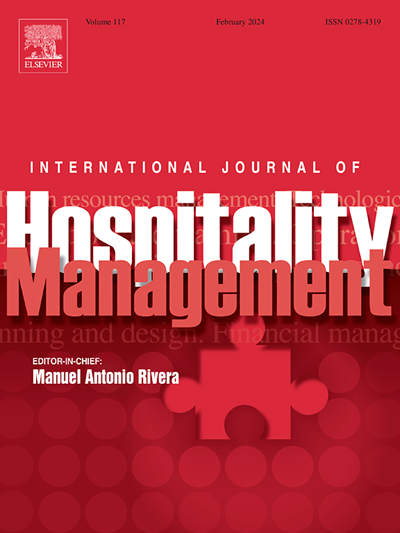主题餐厅物理环境的线索组合与顾客满意度之间的联系——从系统回避的角度
IF 9.9
1区 管理学
Q1 HOSPITALITY, LEISURE, SPORT & TOURISM
International Journal of Hospitality Management
Pub Date : 2025-01-13
DOI:10.1016/j.ijhm.2024.104055
引用次数: 0
摘要
主题餐厅的顾客满意度主要受物理环境中所有可感知的线索的影响,服务提供者通过对标志、符号和嵌入的意识形态的战略性部署,有目的地进行设计,以建立品牌识别,吸引消费者,刺激附加价值的增长。由于新冠肺炎大流行期间的疫情防控措施,人们在容易拥挤的公共场所的个人防护意识有所提高。除了上述的享乐因素外,我们亦应强调卫生或安全因素,以减低顾客的不安全感,同时传达理想的服务精神,从而达致提高顾客对环境整体满意度的目标。然而,在大流行后时期,从系统的“方法回避”角度来看,对综合物理环境线索与消费者满意度之间的因果规律知之甚少。本研究旨在利用汇总案例分析(ACA)和粗糙集方法(RSA)来确定主题餐厅的物理环境线索与消费者满意度之间的关系。利用蚁群算法提取了主题餐厅的14个关键条件属性和每个属性的关键特征。随后,利用RSA建立了13条决策规则。研究结果有助于研究实体环境与消费者对主题餐厅满意度之间的因果关系,并有助于决策者根据用户满意度选择有效的干预措施来提高主题餐厅的质量。本文章由计算机程序翻译,如有差异,请以英文原文为准。
Links between cue combinations of physical environments and consumer satisfaction in themed restaurants from a systematic approach–avoidance perspective
Customer satisfaction with themed restaurants is predominantly influenced by all the perceivable cues of the physical environment, purposefully designed by service providers through the strategic deployment of signs, symbols, and embedded ideologies to establish brand identity, attract consumers, and stimulate the growth of added value. Due to epidemic prevention and control practices during the COVID-19 pandemic, the awareness of personal protection in public spaces prone to crowding has increased. In addition to the previous hedonic cues, hygiene or safety cues should be emphasised to minimise customers’ perceptive insecurity and simultaneously convey a desirable service spirit, to achieve the goal of improving consumers' overall environmental satisfaction. However, there is little understanding of the causal rules between comprehensive physical environmental cues and consumer satisfaction from a systematic ‘approach–avoidance’ perspective in the post-pandemic period. This study aimed to identify the relationship between the physical environment cues of themed restaurants and consumer satisfaction using aggregated case analysis (ACA) and the rough set approach (RSA). A total of 14 key conditional attributes of themed restaurants and the key characteristics of each attribute were extracted using ACA. Subsequently, 13 decision-making rules were established using RSA. The findings contribute to the research on cause-and-effect relationships between physical environments and consumer satisfaction with themed restaurants and would help decision-makers select efficient interventions to improve the quality of such restaurants based on user satisfaction.
求助全文
通过发布文献求助,成功后即可免费获取论文全文。
去求助
来源期刊

International Journal of Hospitality Management
HOSPITALITY, LEISURE, SPORT & TOURISM-
CiteScore
21.20
自引率
9.40%
发文量
218
审稿时长
85 days
期刊介绍:
The International Journal of Hospitality Management serves as a platform for discussing significant trends and advancements in various disciplines related to the hospitality industry. The publication covers a wide range of topics, including human resources management, consumer behavior and marketing, business forecasting and applied economics, operational management, strategic management, financial management, planning and design, information technology and e-commerce, training and development, technological developments, and national and international legislation.
In addition to covering these topics, the journal features research papers, state-of-the-art reviews, and analyses of business practices within the hospitality industry. It aims to provide readers with valuable insights and knowledge in order to advance research and improve practices in the field.
The journal is also indexed and abstracted in various databases, including the Journal of Travel Research, PIRA, Academic Journal Guide, Documentation Touristique, Leisure, Recreation and Tourism Abstracts, Lodging and Restaurant Index, Scopus, CIRET, and the Social Sciences Citation Index. This ensures that the journal's content is widely accessible and discoverable by researchers and practitioners in the hospitality field.
 求助内容:
求助内容: 应助结果提醒方式:
应助结果提醒方式:


